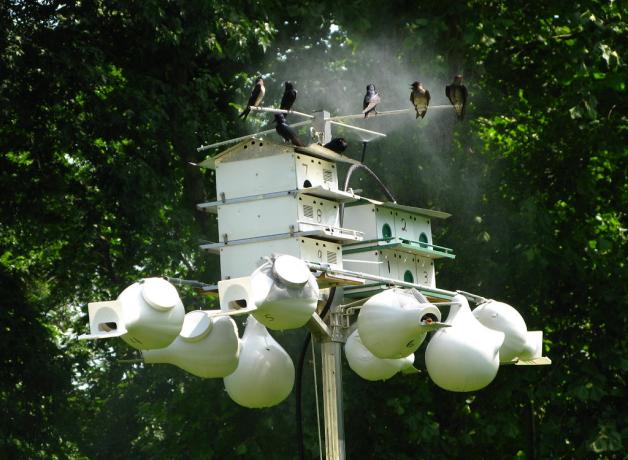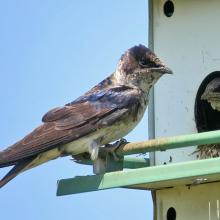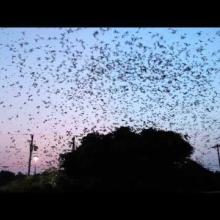

Join BirdNote tomorrow, November 30th!
Illustrator David Sibley and actor H. Jon Benjamin will face off in the bird illustration battle of the century during BirdNote's Year-end Celebration and Auction!
It won’t be long before North America’s largest swallows, Purple Martins, will be looking for places to nest. They’ll be arriving from as far away as Venezuela and Brazil. In eastern North America, where most martins breed, they nest almost exclusively in human-made houses - like the one pictured here. In the West, they also raise their young in natural cavities and woodpecker holes. Providing housing is important because Purple Martins are decreasing significantly in some regions.
BirdNote®
Helping Purple Martins
Written by Gordon Orians
This is BirdNote.
[Songs of Purple Martins]
It won’t be long before North America’s largest swallows, Purple Martins, will be looking for places to nest. They’ll be arriving from as far away as Venezuela and Brazil.
[Songs of Purple Martins]
In eastern North America, where most martins breed, they nest almost exclusively in human-made houses. [Building a birdhouse] In the West, they also raise their young in natural cavities and woodpecker holes.
The birds need specially designed communal houses, as well as adequate open space where they can hunt flying insects. They prefer nest boxes mounted on poles 10 to 17 feet high and at least 30 feet away from human homes. Also, martins may not colonize new sites unless recordings of calls are broadcast to attract them.
[Flock calls of Purple Martins]
Providing housing is important because Purple Martins are decreasing significantly in some regions. Populations have declined by more than 50 percent in Florida and in the upper Midwest. Why? It’s likely from the loss of natural cavities and suitable habitat, and increased competition for the nest sites from European Starlings and House Sparrows.
So if you put up communal nest boxes for Purple Martins, place them near open water and plug the entrances to keep out invaders until the martins arrive in spring.
You’ll find a link to the Purple Martin Conservation Association on our website, birdnote.org. I’m Mary McCann.
[Songs of Purple Martins]
###
Bird sounds provided by The Macaulay Library of Natural Sounds at the Cornell Lab of Ornithology, Ithaca, New York. Song of Purple Martin [76529] recorded by C.A. Marantz; calls of flock [176246] recorded by G.A. Keller.
Tool sounds by Kessler Productions.
BirdNote’s theme music was composed and played by Nancy Rumbel and John Kessler.
Producer: John Kessler
Executive Producer: Chris Peterson
© 2014 Tune In to Nature.org February 2014 Narrator: Mary McCann
ID# PUMA-04-2014-02-26 PUMA-04
The Purple Martin Conservation Association is a group dedicated to scientific research, state-of-the-art management and public education. http://www.purplemartin.org/





